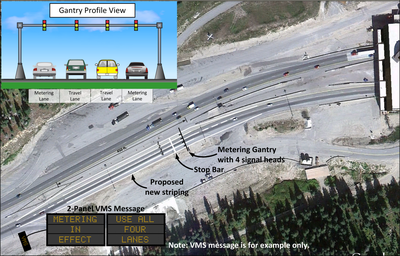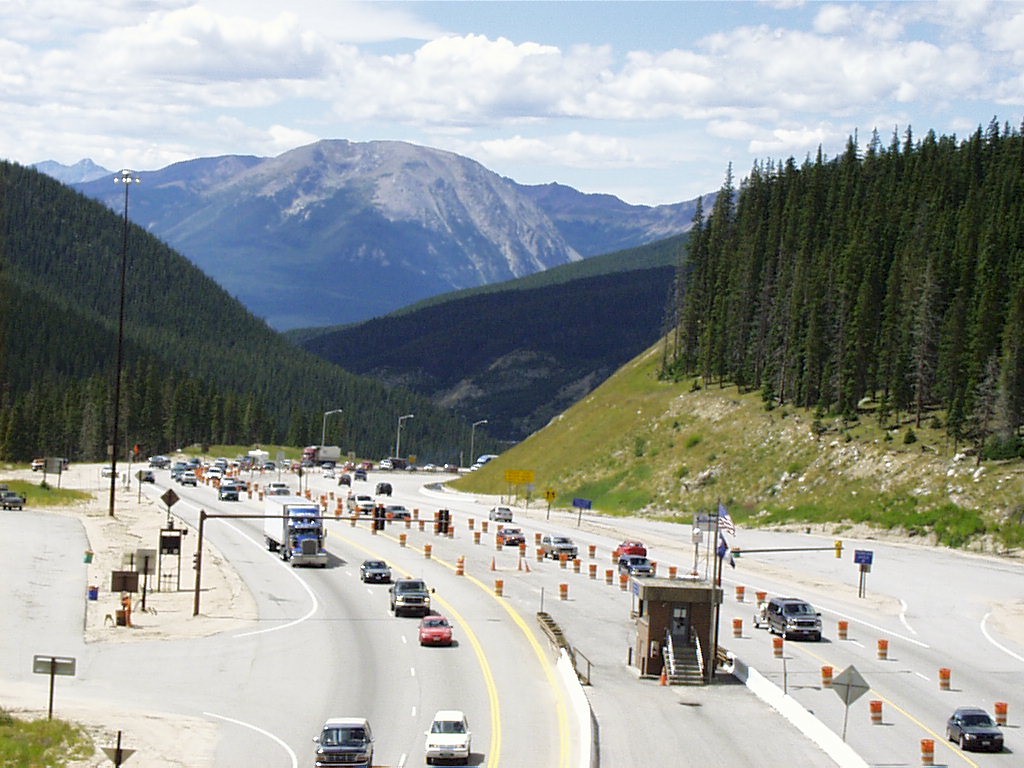Eisenhower Tunnel Metering
 Metering Overview
Metering Overview
The Colorado Department of Transportation will be testing a new way of metering traffic during congested periods at the Eisenhower Johnson Memorial Tunnels. This new method of metering traffic is similar to the traffic signals located at on-ramps that regulate the flow of traffic entering the highways and Interstates in the Denver metro area. Traffic signals will be used to create four lanes of eastbound I-70 on the west side approach to the tunnel tunnel allowing CDOT to better control the flow of traffic entering the tunnel.
Background:
For the past 25 years, CDOT has metered traffic at the Eisenhower Tunnel when traffic volumes exceed of the capacity of the highway or when an accident or inclement weather causes traffic to come to a standstill, backing up into the tunnel. When traffic backs up into the tunnel, CDOT stops all inbound vehicles from entering the tunnel until the back-ups clear. This is done for safety reasons. As there are no shoulders in the tunnels, emergency vehicles must be able to respond to an accident, fire or medical emergency and they can’t get through when traffic is at a standstill. When metering is underway, CDOT stops all traffic from entering the tunnel. Traffic is stopped for 15-20 minutes at a time on average but it can take much longer for the end of the traffic queue to get moving again.
New Continuous Flow Metering:
Instead of just stopping all traffic, CDOT will be trying a new method of metering traffic. This method is used in other states like California and New Jersey. This method is similar to the ramp metering method used in the Denver metro area and other congested areas. When metering becomes necessary, as traffic approaches the tunnel, it will be spread into four lanes with traffic signals located above each lane. The traffic signals will be used to alternate lanes of traffic in an effort to more efficiently regulate the flow of traffic into the tunnel. The traffic signals will cycle every 4-8 seconds so that vehicles will only have to stop briefly before being allowed to enter into the tunnel.
CDOT hopes that this continuous flow metering with only brief stops will reduce the delays caused by traditional metering. For every minute traffic is stopped for metering, it can take as much as eight minutes to get the backed up traffic moving again.
Facts about Metering:
- Metering is not a preventative measure but rather is reactive to traffic conditions. CDOT will continue metering only as a last resort when there is gridlock in the tunnel.
- Metering is not being done as a congestion relief measure. While reduced delay may be a benefit of continuous flow metering, it’s not likely to be a significant improvement.
- Metering will not work if there is a severe accident or something that results in no traffic movement.
- CDOT does not meter for air quality. The only reason CDOT meters traffic is for safety.
- When continuous flow metering is in effect, flaggers will direct traffic into the four-lane configuration. The highway will not be widened to four lanes. The four-lane configuration will only be in place if metering is underway.
Metering Frequently Asked Questions (FAQ)

Why does the Colorado Department of Transportation stop traffic at the Eisenhower/Johnson Tunnel?
The primary reason is the safety of the traveling public. CDOT holds or "meters" traffic at the tunnel when vehicle volumes exceed the capacity of the Interstate 70 corridor. Accidents, adverse weather or other problems along the corridor also can cause traffic to back up into the tunnel. When back-ups occur within the tunnel, CDOT stops vehicles from entering the tunnel, allowing traffic queues to clear, before releasing more traffic into the tunnel.
How long are the stops when CDOT's metering traffic?
Stops usually average about 20 minutes because that's about how long it takes to clear the queue. However, the stops can be shorter or longer in duration, as traffic and conditions dictate. Even though traffic is stopped for a period of time, it quickly catches up to the slower-moving vehicles ahead.
Why is it critical to maintain traffic flow through the tunnel?
Inside the tunnel, there are only two lanes, no pull-outs or shoulders, and vehicles are wedged together tightly. That is why CDOT does not allow traffic to back up in the tunnel to the point where crews would not be able to respond to a medical emergency, accident, fire or other problem in a timely manner.
When does metering usually take place?
Eastbound metering occurs primarily on weekends, usually on Sunday afternoons, when heavy traffic can slow the flow of vehicles to a crawl, creating gridlock conditions. Heavier-than-usual traffic can be expected from January to March, due to additional skier traffic, and in July and August, when summer tourist and recreational traffic traditionally is at its peak. However, tunnel metering can take place on eastbound and/or westbound I-70 at any time due to accidents, or for avalanche control work during daylight hours in the winter.
When CDOT stops traffic at the tunnel, doesn't it slow down all eastbound traffic?
It actually doesn't slow traffic down; it allows it to flow more efficiently. CDOT traffic engineers have studied the time differential when metering is taking place and, while traffic may initially be stopped for 20 minutes, the actual delay is about 3 ½ minutes. That's because eastbound traffic is moving more slowly and the released vehicles eventually catch up with traffic further east down the corridor.
Is tunnel metering a new traffic control measure?
No. Vehicle metering has been taking place at the tunnel for nearly 20 years.
Are there any other reasons traffic is stopped at the Eisenhower/Johnson Tunnel?
Yes. Trucks carrying hazardous materials are not allowed to travel through the tunnel and must use Loveland Pass (US 6). But during the winter, adverse weather frequently closes the pass, requiring hazmat vehicles to travel through the tunnel. Due to safety concerns, CDOT does not allow hazmat to travel through the tunnel with other vehicles. Therefore, usually at the top the hour, CDOT escorts waiting hazmat loads through the tunnel. These closures last about 15 minutes.
How can I find out when metering is taking place?
Information is available by calling 511, or by checking COtrip. CDOT also notifies the traveling public via the electronic message signs that are on I-70, and any available electronic signs on US 6 and Colorado Highway 9 in Summit County.
